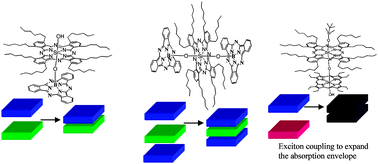Towards black chromophores: μ-oxo linked phthalocyanine–porphyrin dyads and phthalocyanine–subphthalocyanine dyad and triad arrays†
Abstract
A versatile synthetic strategy based on the use of a non-peripherally substituted dihydroxysilicon phthalocyanine and dihydroxygermanium octaethylporphyrin has permitted controlled construction of heterodyads that absorb across the whole visible spectrum; the same


 Please wait while we load your content...
Please wait while we load your content...